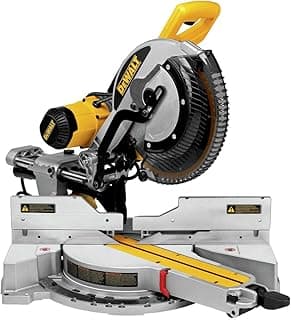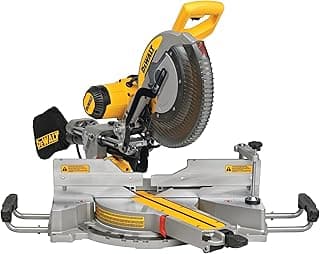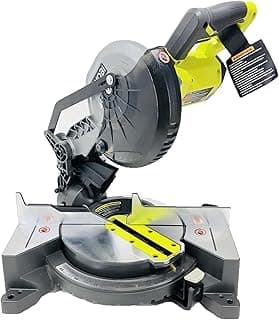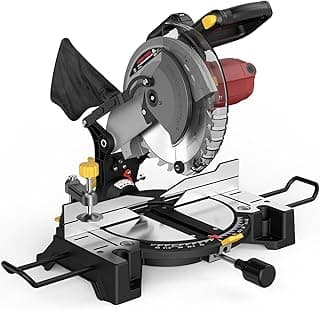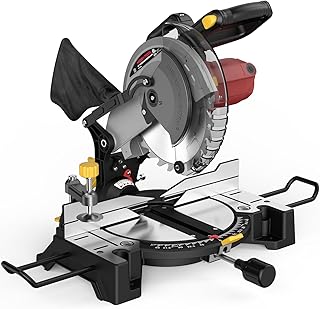When it comes to woodworking on the go, finding the best portable miter saw can make all the difference. These compact yet powerful tools deliver clean, accurate cuts whether you’re trimming, framing, or crafting detailed joints. But here’s the thing—you need to know which features truly matter before you buy.
Need something smaller? You might also want to check out the best small miter saw options for lighter jobs. Or perhaps you’re focused on finishing work—then the best miter saw for trim work could be a better fit. And if you want raw cutting power, the best chop saw deserves your attention.
Ready to discover which portable miter saw is worth your investment? Let’s dive in.
Top Picks
Best Precision Cut: DEWALT Miter Saw, 12 Inch Double Bevel Sliding Compound Miter Saw
The DEWALT DWS779 12-Inch Sliding Miter Saw delivers impressive precision and power for both professionals and serious DIY users. Its 15-amp motor runs at 3800 RPM, providing clean, consistent cuts through hardwood, metal, and composite materials. The sliding design increases cutting capacity, while the stainless steel miter detent plate ensures accuracy with minimal recalibration. Users appreciate the solid, brushed metal construction that enhances durability and reduces vibration during operation.
Many owners highlight how effortlessly the saw handles wide crown moldings and framing lumber, noting its smooth bevel and crosscut adjustments. The included carbide blade performs well for most tasks, and the brushless feature adds to its efficiency and long-term reliability. However, at 56 pounds, it is not ideal for frequent transport between job sites. Overall, customers value the DWS779 for its precision, sturdiness, and reliable DEWALT engineering—making it a trusted tool for precise, high-quality cuts.
Best Cordless Precision: DEWALT 20V MAX 7-1/4-Inch Miter Saw, Tool Only
The DEWALT DCS361B 20V MAX Miter Saw offers an ideal blend of portability and accuracy for on-site and workshop projects. Weighing just 30 pounds, it’s easy to move and set up, making it a favorite among contractors who value efficiency and mobility. The 20-volt lithium-ion system powers a 4500 RPM motor, delivering strong, consistent cutting performance through wood and metal surfaces. Its bevel capability adds flexibility for angled cuts, while the brushed motor maintains reliable output for long-term use.
Users praise its precise miter scale and the smooth action of the spindle lock, which simplifies quick blade changes. The included carbide blade provides clean results even on hardwood materials. Though some mention the inconvenience of purchasing the battery separately, most agree that its cordless design and cutting accuracy outweigh this drawback. In real-world use, the DCS361B stands out as a dependable, lightweight miter saw that balances power, precision, and convenience for everyday job demands.
Best Single Bevel Power: DEWALT 12-Inch Miter Saw, 15-Amp, Single Bevel
The DEWALT DWS715 12-Inch Single Bevel Compound Miter Saw is built for consistent accuracy and reliability in woodworking applications. Powered by a 15-amp, 1800-watt motor running at 4500 RPM, it delivers fast, clean cuts through hardwood and framing lumber. The stainless steel miter detent plate offers solid, repeatable accuracy with minimal adjustment, while the carbide-tipped blade maintains sharpness even under heavy use. Despite its robust performance, the saw remains manageable at 42.8 pounds—light enough for transport yet sturdy on the bench.
Users appreciate the precision of the single-bevel system for tasks like trim work, framing, and molding. Many note that its cutting capacity and power outperform expectations for a corded model in this class. The brushless motor enhances efficiency and longevity, reducing maintenance needs. While the single bevel design limits dual-angle flexibility, owners agree that the DWS715 delivers dependable power, smooth operation, and excellent value for both professional and home workshop projects.
FAQs
Is a 10 or 12-inch miter saw better?
Choosing between a 10-inch and a 12-inch miter saw depends on your typical projects. A 10-inch saw is lighter, more portable, and ideal for trim, molding, and small framing work. Its blades are cheaper and spin faster, giving smoother cuts on fine materials.
A 12-inch saw, on the other hand, offers greater cutting capacity and power. It’s perfect for larger lumber, wide boards, and professional setups. The downside? It’s heavier, costlier, and less mobile.
In short, if you prioritize portability and finesse, go for a 10-inch saw. But if you frequently cut thick stock or wide boards, the 12-inch model delivers superior reach and performance.
What is the difference between a cheap and expensive miter saw?
The gap between cheap and expensive miter saws lies in build quality, precision, and features. Budget saws often use lighter materials, basic motors, and minimal adjustment mechanisms. They work fine for occasional DIY projects but may lack long-term accuracy and durability.
Premium models, however, include better bearings, laser or LED cut guides, smoother sliding rails, and more powerful motors. These features ensure cleaner cuts, tighter tolerances, and faster setups. Expensive saws also handle demanding workloads without overheating or losing alignment.
In short, the higher price often reflects professional-grade reliability and precision—vital if you rely on your tool daily.
Which is better, a miter saw or a sliding miter saw?
It depends on the type of cuts you need. A standard miter saw moves only up and down, making it great for quick, angled cuts on narrow materials like trim or molding. It’s simpler, lighter, and easier to carry around.
A sliding miter saw, by contrast, includes rails that allow the blade to move forward and backward. This feature dramatically increases the cutting width, making it perfect for wider boards and larger projects.
If you work mostly on small trim pieces, the non-sliding version is efficient and portable. But if you often cut wide planks or need maximum versatility, the sliding miter saw is the better investment.
Can I cut a 4x4 with a 10-inch sliding miter saw?
Yes, but with a few limits. A 10-inch sliding miter saw can cut through a 4x4 post in a single pass only if the saw’s design and cutting capacity allow it—usually just barely. Some models may require flipping the wood and cutting from both sides for a complete pass.
For smoother performance and fewer adjustments, a 12-inch sliding saw handles 4x4s effortlessly. However, if portability is key, the 10-inch version remains a practical compromise, delivering accuracy and control in a lighter frame.
Final Thoughts
A portable miter saw bridges the gap between precision and convenience, giving craftsmen and DIYers the flexibility to work anywhere. Whether you choose a 10-inch or 12-inch model, standard or sliding design, the best option is the one that matches your cutting demands and workspace. Focus on build quality, cutting capacity, and portability—then you’ll have a saw that performs reliably for years.

